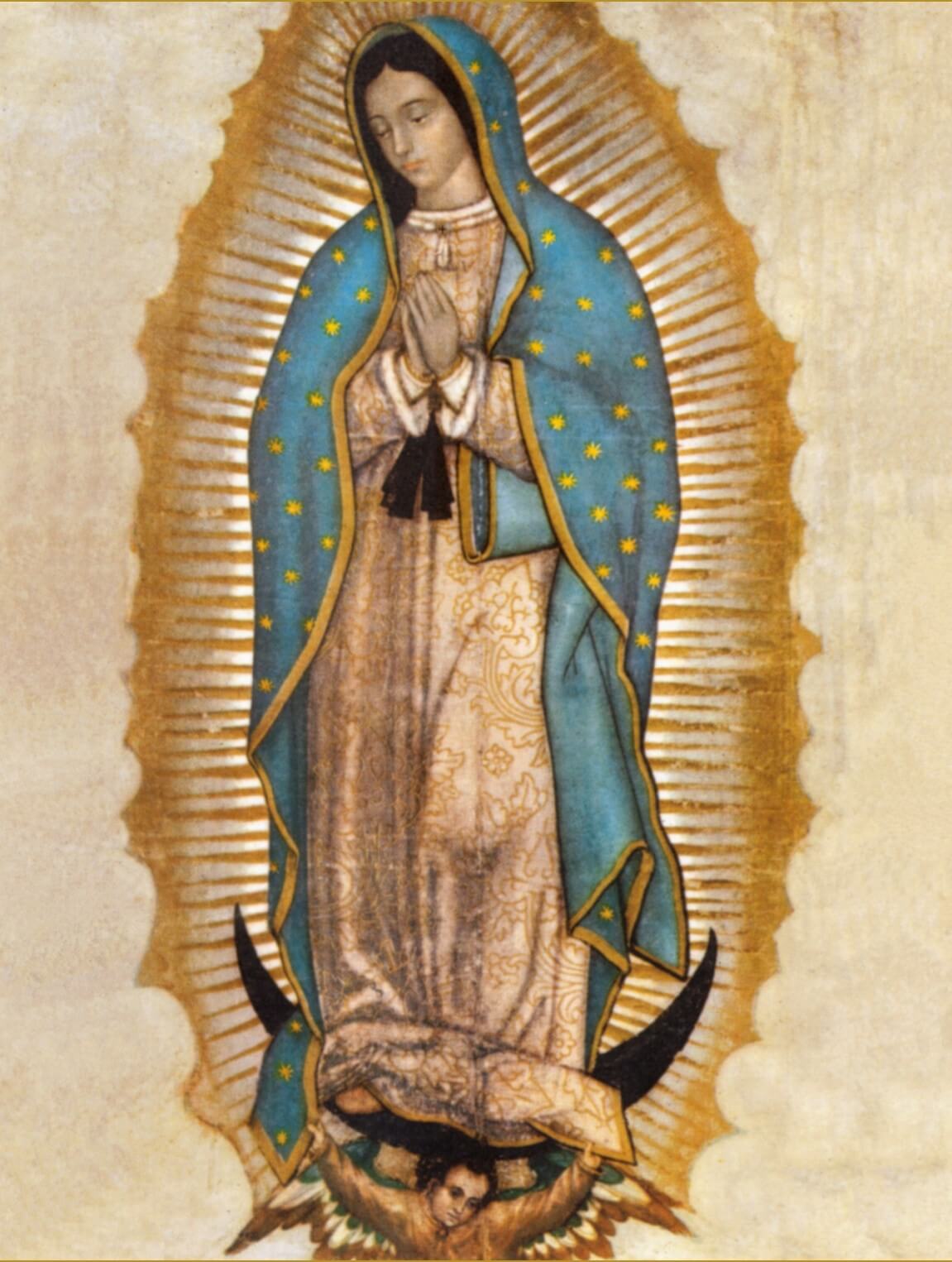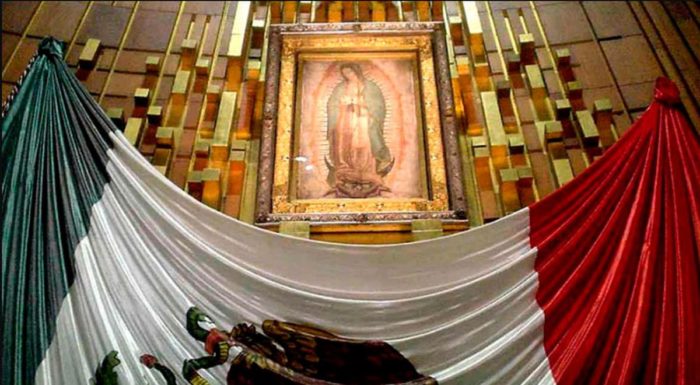Historically in Mexico, for centuries, the Virgin of Guadalupe has been, in addition to religious motivation, a factor of national unity and has been presented by the Catholic Church as the greatest Mexican miracle. However, behind her cult, there is another, more ancient one.
Every December 12, the Virgin of Guadalupe is celebrated in Mexico. A celebration that, according to legend, on December 9, 1531, made the first appearance to Juan Diego on the hill of Tepeyac, north of Mexico City. In this encounter, believed with fervor by millions of Mexicans, Catholic or not, the Virgin asked Juan Diego to go with Archbishop Fray Juan de Zumárraga of the newly created viceroyalty of New Spain to build a temple on the top of the hill.
The friar did not believe his words and asked for proof. When Juan Diego returned to his divine encounter, the Virgin ordered him to take roses in his tilma. The miracle occurred when Juan Diego unrolled it and released the flowers in front of the friar. The Virgin of Guadalupe was miraculously printed on the garment, which has lasted almost 500 years, currently in the Basilica of Guadalupe. A story that every Mexican has known since childhood.
But let’s go back in time. Before the Spanish conquest, there was a temple of worship to the goddess Tonantzin, which gathered people from all over the Aztec empire. Accounts collected by the Spanish friars attest to this. The Mexica and other Nahua believed that the mother of the gods appeared at the top of the Tepeyac hill: “The natives highly venerated the goddess. According to testimonies, she appeared to one of them at a time in the form of a young girl with a white tunic and revealed secret things to the person”. According to Fray Juan de Torquemada in “Monarquía India” of 1615.
Fray Bernardino de Sahagún said in his texts that in the mountain called “Tepeaca” or “Tepeyac,” there was a temple dedicated to what he called “the mother of all gods, Tonantzin.” Sacrifices were dedicated to this revered figure, and men and women from all regions went to worship her.
Tonantzin – The snake woman

The Aztec religion had a mysterious syncretism that researchers have yet to be able to solve: the mutation of Tonantzin into different names but with the same meaning. She was called Tonantzin, Coatlicue, Cihuacóatl, or Tetéoinan. A “divine mother” for the Mesoamericans. Under the name of “Cihuacóatl” or “the serpent woman,” this goddess served as a protector of women.
An ancient story collected in the writings of Bernardino de Sahagún tells that, before the arrival of the Spaniards, in the lake of Texcoco, the lament of a woman crying was heard saying: “My children, beloved children of Anahuac, your destruction is coming.” The high priests thought it was the goddess Cihuacoatl who prophesied the destruction of Anahuac. Shortly after the defeat of the Mexica people, when the Spaniards destroyed the great “Templo Mayor” and the temple of Tonantzin in Mexico City on the hill of Tepeyac, it is said that again the lament of the goddess was heard crying for her dwelling place that the invader had profaned. This story eventually gave way to the legend of “La Llorona.”
The original Virgin of Guadalupe.

Santa María de Guadalupe – Cáceres, España.
In the 14th century, in the province of Cáceres, Spain, on the banks of the “Guadalupe River” -a word of Moorish and Latin origin -Wad-al/river and Lupus/ wolves-, meaning “river of wolves”- a legend developed. It tells that the shepherd Gil Cordero found a brown statuette of the Virgin Mary, which is said to have worked several miracles in that region. Years later, during the conquest of America, she was designated by the Catholic Monarchs of Spain as protector of “the Indians of the New World because of her brown complexion.”
When Hernán Cortés, the conqueror of Tenochtitlan, arrived in the “new world,” he carried the banner of the Virgin of Extremadura, of which he was a faithful devotee since he came from the Guadalupana region.
The Mexican historian Edmundo O’Gorman (1906 – 1995) warns in some of his notes that, by the year 1530, the Franciscan friars built a hermitage dedicated to the Spanish Virgin, trying to substitute the pagan rite for a Catholic one.
The miraculous legend of the image captured in the tilma of Juan Diego takes another view when analyzing the symbols manifested in the image, which contains elements of totally pre-Hispanic ideas, but represented with Catholic symbols. For example, it includes rhetoric such as “The Flower and the Song,” one of the philosophies of the Aztec world. Even the story of the Guadalupan myth takes on another force and meaning when the cult of Tonantzin is better understood from the perspective of the rhetorical resources of Nahuatl poetry written in the “Nican-Mopohua.”
The image of the Virgin of Guadalupe. A miracle or an invention?
According to available historical records, the apparition of the Virgin of Guadalupe dates back to 1531. Since then, it has generated a solid devotion among Mexicans, to the point that Mexico is considered a Guadalupan nation even more than a Catholic one.
The most widespread cult in Mexico is undoubtedly that of the Virgin of Guadalupe. However, as the years have gone by, the Guadalupan tilma has been the subject of several investigations. One of these corresponds to the authorship of the image, removing its divine character and giving it an earthly origin and an author. The indigenous painter: Marco Cipac de Aquino. The man who conceived the idea of the Virgin of Guadalupe.
Who was Marcos Cipac de Aquino?

The provincial of the Franciscans, Fray Francisco de Bustamante, in 1556, stated that the image of the Virgin was the work of Marcos Cipac de Aquino. Historian Augusto Vallejo Villa claims to have unique information about Cipac and his work.
Vallejo found several letters from Fray Francisco de Bustamante in which he refers to the artist -with first and last name- as the only author of the Guadalupana image. In addition, the priest mentions him several times as “the Indian Marcos.” Finally, he attributes the creation of the painting to him. Bustamante is one of many who mention him. Besides him, Bernal Díaz del Castillo, author of “La historia verdadera de la conquista de la Nueva España” (1555-1575), repeatedly recognizes Marco Cipac de Aquino as “one of the three excellent native painters” of the “New World.”
The cult of the Virgin of Guadalupe is based on the myth of Juan Diego; however, it is a reality that the image comes from a colonial historical context where evangelization campaigns spread throughout the American continent. Its appearance corresponds to a social context of political and spiritual colonization during the 16th century. Those who have dedicated themselves to investigating the origins of the cult of the Virgin of Guadalupe found that Marcos Cipac de Aquino, nicknamed “Griego,” was one of the most recognized painters of his time.
Gisela von Wobeser, in her work “Antecedentes iconográficos de la imagen de la Virgen de Guadalupe,” published by the UNAM in October 2015, explains, “This hypothesis seems viable because of the quality of the painting since Marcos Cipac lived between 1517 and 1572. Therefore, he could have made the painting when he was young. In addition, we know that he later participated in the realization of the main altar of the chapel of San José de los Naturales in the convent of San Francisco in Mexico. This indicates that he was close to the Franciscans and that they valued his work”.
“The painter,” -says von Wobeser-“adapted a European engraving of the Virgin in La Gloria to channel devotion to the Virgin of Guadalupe and thus contribute to the evangelization of the indigenous people. Both virgins are similar. However, the piece on display in the Basilica of Guadalupe does not have a child in her arms because the Catholic Church promoted the cult of an “immaculate woman.”
—
I end this writing with the following reflection:
For most of us Mexicans, the cult of the Virgin of Guadalupe is not questionable. Much less if the apparitions are real or not. The core of this epic story lies in the deep religious fervor that for almost 500 years continues to bring millions of people to the Basilica of Tepeyac to ask the Virgin for favors and her miraculous intervention and help to heal our ills.
Fidelity to the cult of the Virgin of Guadalupe enriches and contributes spiritual elements with a root that predates even the conquest – a tradition of faith, ritual, and myth – that comes from our pre-Hispanic origins. We embrace this syncretism in a melting pot where the ancient meets the modern, and we cling to our Guadalupan faith.
For Times Media Mexico / The Yucatan Times
José E. Urioste
Merida Yucatan, Mexico
December 12, 2022
[email protected]



